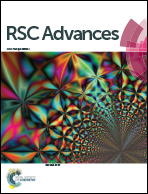Retracted Article: Effectiveness of some novel heterocyclic compounds as corrosion inhibitors for carbon steel in 1 M HCl using practical and theoretical methods†
Abstract
Corrosion of carbon steel is a major problem that destroys assists of industries and world steel installations; the importance of this work is to introduce new heterocyclic compounds as effective and low-cost corrosion inhibitors. Three compounds of carbohydrazide derivatives, namely: 5-amino-N′-((2-methoxynaphthalen-1-yl)methylene)isoxazole-4-carbohydrazide (H4), 2,4-diamino-N′-((2-methoxy-naphthalene-1-yl)methylene) pyrimidine-5-carbohydrazide (H5) and N′-((2-methoxynaphthalen-1-yl)methylene)-7,7-dimethyl-2,5-dioxo-4a,5,6,7,8,8a-hexahydro-2H-chromene-3-carbohydrazide (H6) were used to examine the efficacy of corrosion of carbon steel in 1 M hydrochloric acid solution. This corrosion efficacy was detected by utilizing various methods including electrochemical impedance spectroscopy (EIS), potentiodynamic polarization (PDP), weight loss measurements (WL), surface morphology analyses by atomic force microscopy (AFM), quantum chemical computations based on density functional theory (DFT) and molecular dynamics (MD) simulation. The results indicated that these compounds act as mixed type inhibitors i.e. reduce the corrosion rate of carbon steel due to the formation of a stable protective film on the metal surface and reduce the cathodic hydrogen evolution reaction. As confirmed from impedance, carbohydrazide derivatives molecules are adsorbed physically on metal surface with higher corrosion efficacy reached to (81.5–95.2%) at 20 × 10−6 M concentration at room temperature. Temkin isotherm model is the most acceptable one to describe the carbohydrazide derivative molecules adsorption on the surface of carbon steel. Protection mechanism was supported by quantum chemical analyses and Monte Carlo modeling techniques. The theoretical calculations support the experimental results obtained. This proves the use of carbohydrazide derivatives as a very effective inhibitors against the corrosion of carbon steel in acidic media.



 Please wait while we load your content...
Please wait while we load your content...